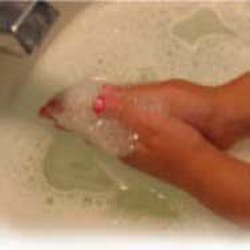"Happy birthday" song can be important tool in hand washing
Studies have proven that hand washing is the most important measure in preventing the transmission of infectious diseases. (1, 2) In addition to washing hands regularly after using bathroom facilities and before eating, healthcare providers, including dentists, must practice hand hygiene at other essential times throughout their day. These times include before any contact with the patient with or without glove protection, after contact with blood, saliva, and other bodily fluids, or contact with contaminated surfaces even when wearing gloves, before invasive procedures, and after removing PPEs. (1, 2)
Wetting hands with clean, running water, applying soap, and massaging together to produce a soapy lather performs the most effective hand washing. Special care should be taken to scrub the backs, in between each finger, and under the fingernails. Scrubbing should continue for at least 20 seconds, which happens to be the amount of time it takes to hum the “Happy Birthday” song twice. Hands should be rinsed thoroughly under running water and dried. Previously used towels can harbor bacteria, so it is preferable to use a disposable towel or an air dryer. (2) VioNex Antimicrobial Liquid Soap by TotalCare is recommended for use before contact with the patient, after treatment, after contact with blood and/or other bodily fluids, pathogens, contaminated surfaces, and after the removal of PPEs. (1, 2) It is formulated to be gentle and non-irritating for handwashing 30-50 times per day and is effective for broad-spectrum germ killing and skin cleansing.
If soap and water are unavailable, an alcohol-based hand sanitizer can be used. The sanitizer should contain at least 60% alcohol. Although alcohol-based hand sanitizers decrease germ count, they do not eliminate all types of germs and are not effective when hands are visibly dirty or soiled with blood or other bodily fluids. Hand sanitizers are applied to the palms and rubbed over the surfaces of the hands, including the backs, between each finger, and under the fingernails. Although proven effective, hand sanitizers should not be relied upon to replace traditional hand-hygiene. (1) When appropriate, VioNexus No Rinse Spray (TotalCare) is used in dental practices in place of, and sometimes in addition to, hand washing. Formulated with 65.87% ethyl Alcohol, according to the manufacturer, 99% of bacteria are eradicated in as little as 15 seconds. VioNexus No Rinse Spray provides a convenient and economical way to cleanse and kill germs on your hands when soap and water are not available. It is formulated with cleansers, skin conditioners, and the active ingredient Benzalkonium Chloride, to provide germ-killing effectiveness that will not dry the skin.
Since many new handwashing agents have appeared recently, the infection control practitioner selecting products needs to be actively involved to make certain that the agent meets the needs of the facility. Here is a list of the different types of handwashing agents. (3)
Soap — A cleansing and emulsifying agent made active by the action of an alkali on fat or fatty acids and consisting mainly of sodium or potassium salts of such acids. Nonantimicrobial soap is a detergent-based cleanser — liquid, bar, leaflet, or powder — that is used for physically removing soil and microorganisms. Soaps work as surfactants, breaking the surface tension of water to help in the mechanical removal of soil, yet they have no bacterial activity. (3)
Lotion — A liquid, medicinal preparation containing one or more insoluble substances and applied externally to skin for conditioning or treating disorders. (3)
Antimicrobial — Destroying or inhibiting the growth of microorganisms. (3)
Antiseptic — Opposing sepsis, putrefaction, or decay. "Antiseptic" also means arresting the growth of microorganisms on living tissue. An antiseptic handwash agent shows antimicrobial activity and is designed for use on skin to remove both transient and resident bacterial flora. (3)
References
1. Center for Disease Control. Healthcare-associated infections. http://www.cdc.gov/hai/
2. Andrews N. Breaking the chain of infection: Practical and effective infection control. July 2007.
3. Higa L. New technologies in handwash products. Aug. 1, 2000.
